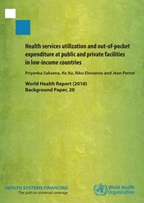Financial protection
Financial protection is at the core of universal health coverage (UHC) and one of the final coverage goals. Health financing policy directly affects financial protection. Financial protection is achieved when direct payments made to obtain health services do not expose people to financial hardship and do not threaten living standards.
Key to protecting people is to ensure prepayment and pooling of resources for health, rather than relying on people paying for health services out-of-pocket at the time of use.
About 930 million people (12.7 percent of the world’s population) incurred catastrophic health spending as they dedicated at least 10 percent of their household budgets to pay for health care out of their own pockets. About 90 million people (1.2 percent of the world population) are still being pushed into “extreme poverty” (living on $ 1.90 (1) or less a day) because they paid for health care out-of-pocket.
There are different ways of organizing the financing of health systems to ensure a population is financially protected. However, what is clear is that health systems need to predominantly rely on public revenue sources: mandatory, pre-paid and pooled, rather than voluntary pre-payment mechanisms.
Financial protection is not guaranteed by entitlement and membership to a health coverage scheme, as broader changes in the health system are required. Some common aspects of successful reforms include:
- pooled or coordinated use of different revenue sources;
- progressively increasing the size of compulsory prepaid funds;
- redistribution of money form prepaid funds; and
- new organizations and institutional arrangements to support and enable change.
Financial protection can be monitored by looking at how much people spend relative to their ability to pay (e.g. household total expenditure or income as within the SDG monitoring framework or household total expenditure or income net of spending on necessities).
Monitoring progress towards financial protection at global level is important but in-depth contextual specific analysis and evaluations of health financing policies are needed to understand drivers of trends.










